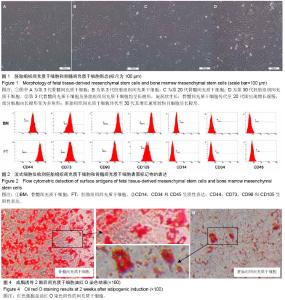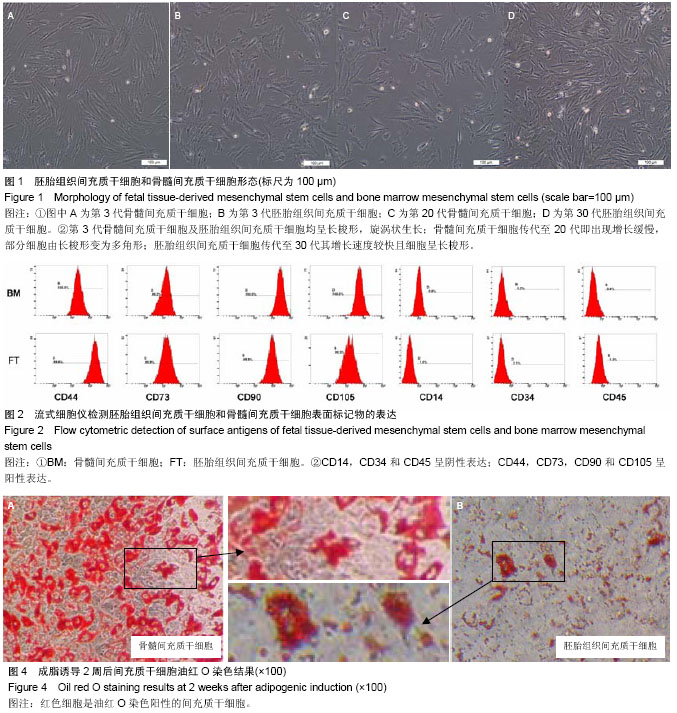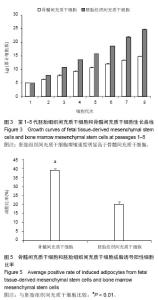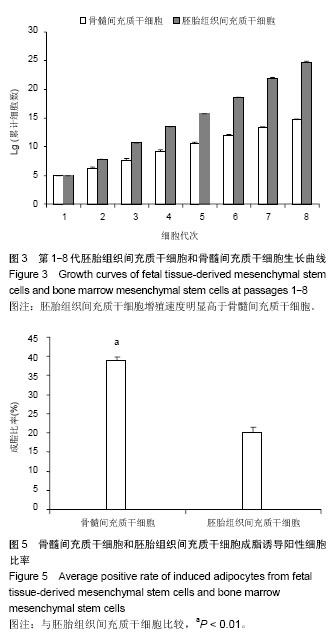| [1] Friedenstein AJ, Deriglasova UF, Kulagina NN,et al.Precursors for fibroblasts in different populations of hematopoietic cells as detected by the in vitro colony assay method.Exp Hematol. 1974;2(2):83-92.
[2] Pittenger MF, Mackay AM, Beck SC,et al.Multilineage potential of adult human mesenchymal stem cells.Science. 1999;284(5411):143-147.
[3] Romanov YA, Svintsitskaya VA, Smirnov VN.Searching for alternative sources of postnatal human mesenchymal stem cells: candidate MSC-like cells from umbilical cord.Stem Cells. 2003;21(1):105-110.
[4] Campagnoli C, Roberts IA, Kumar S,et al.Identification of mesenchymal stem/progenitor cells in human first-trimester fetal blood, liver, and bone marrow.Blood. 2001;98(8):2396-2402.
[5] Johnstone B, Hering TM, Caplan AI,et al.In vitro chondrogenesis of bone marrow-derived mesenchymal progenitor cells.Exp Cell Res. 1998;238(1):265-272.
[6] Zuk PA, Zhu M, Mizuno H,et al.Multilineage cells from human adipose tissue: implications for cell-based therapies.Tissue Eng. 2001;7(2):211-228.
[7] Mosna F, Sensebé L, Krampera M.Human bone marrow and adipose tissue mesenchymal stem cells: a user's guide.Stem Cells Dev. 2010;19(10):1449-1470.
[8] Baksh D, Yao R, Tuan RS.Comparison of proliferative and multilineage differentiation potential of human mesenchymal stem cells derived from umbilical cord and bone marrow.Stem Cells. 2007;25(6):1384-1392.
[9] Zhu SF, Zhong ZN, Fu XF,et al.Comparison of cell proliferation, apoptosis, cellular morphology and ultrastructure between human umbilical cord and placenta-derived mesenchymal stem cells.Neurosci Lett. 2013;541:77-82.
[10] Kern S, Eichler H, Stoeve J, et al.Comparative analysis of mesenchymal stem cells from bone marrow, umbilical cord blood, or adipose tissue.Stem Cells. 2006; 24(5):1294-1301.
[11] 仵敏娟,刘善荣,刘厚奇,等.人早期胚胎间充质干细胞的定位和体外初步分离培养[J].第二军医大学学报,2004,25(8):818-821.
[12] 张建华,杨林花.人胚胎间充质干细胞的生长特性及骨髓瘤细胞对其表达核因子κB受体激活剂配体/护骨素的影响[J].中国药物与临床,2010,10(8):888-889.
[13] 叶明珠,刘爱民,韩丽英,等.人早期胚胎源性间充质干细胞的体外分离培养及其生物学特性[J].吉林大学学报:医学版,2007,33(4): 726-729.
[14] Hao L, Sun H, Wang J,et al.Mesenchymal stromal cells for cell therapy: besides supporting hematopoiesis.Int J Hematol. 2012;95(1):34-46.
[15] 仵敏娟.人早胚间充质干细胞向上皮细胞转型的研究(上皮干细胞发育的研究)[D].上海:第二军医大学,2005.
[16] 李红华.人胚胎间充质干细胞向平滑肌细胞分化体外模型的建立及分化机制初探[D].上海:第二军医大学,2004.
[17] 何念海.人胎儿间充质干细胞体外分离培养及诱导分化为类肝细胞的实验研究[D].重庆:第三军医大学,2004.
[18] 何念海,赵文利,王宇明.人胎儿骨髓间充质干细胞体外分离培养及诱导分化为类肝细胞[J].重庆医学,2006,35(21):1923-1928.
[19] 陈焱,张丰深,陈耀凯,等.人胚胎骨髓间充质干细胞大鼠脾脏移植后向肝脏的迁移与分化[J].实用医学杂志,2010,26(23):4305- 4307.
[20] 袁莉,仵敏娟,张懿,等.早期胚胎间充质干细胞在新生小鼠肾脏内的存活和分布[J].中华肾脏病杂志,2009,25(9):683-687.
[21] López Y, Lutjemeier B, Seshareddy K,et al.Wharton's jelly or bone marrow mesenchymal stromal cells improve cardiac function following myocardial infarction for more than 32 weeks in a rat model: a preliminary report.Curr Stem Cell Res Ther. 2013;8(1):46-59.
[22] Martini MM, Jeremias Tda S, Kohler MC,et al.Human placenta-derived mesenchymal stem cells acquire neural phenotype under the appropriate niche conditions.DNA Cell Biol. 2013;32(2):58-65.
[23] Jung J, Choi JH, Lee Y,et al.Human placenta-derived mesenchymal stem cells promote hepatic regeneration in CCl4 -injured rat liver model via increased autophagic mechanism.Stem Cells. 2013;31(8):1584-1596.
[24] Gao X, Song L, Shen K,et al.Bone marrow mesenchymal stem cells promote the repair of islets from diabetic mice through paracrine actions.Mol Cell Endocrinol. 2014. [Epub ahead of print]
[25] Wu H, Mahato RI.Mesenchymal stem cell-based therapy for type 1 diabetes.Discov Med. 2014;17(93):139-143.
[26] Curley GF, Scott JA, Laffey JG.Therapeutic potential and mechanisms of action of Mesenchymal Stromal Cells for Acute Respiratory Distress Syndrome.Curr Stem Cell Res Ther. 2014. [Epub ahead of print]
[27] Le Blanc K.Immunomodulatory effects of fetal and adult mesenchymal stem cells.Cytotherapy. 2003;5(6):485-489.
[28] Rasmusson I, Ringdén O, Sundberg B,et al.Mesenchymal stem cells inhibit the formation of cytotoxic T lymphocytes, but not activated cytotoxic T lymphocytes or natural killer cells.Transplantation. 2003;76(8):1208-1213.
[29] Le Blanc K.Immunomodulatory effects of fetal and adult mesenchymal stem cells.Cytotherapy. 2003;5(6):485-489.
[30] Jang MJ, Kim HS, Lee HG,et al.Placenta-derived mesenchymal stem cells have an immunomodulatory effect that can control acute graft-versus-host disease in mice.Acta Haematol. 2013;129(4):197-206.
[31] Gu YZ, Xue Q, Chen YJ,et al.Different roles of PD-L1 and FasL in immunomodulation mediated by human placenta-derived mesenchymal stem cells.Hum Immunol. 2013;74(3):267-276.
[32] La Rocca G, Lo Iacono M, Corsello T,et al.Human Wharton's jelly mesenchymal stem cells maintain the expression of key immunomodulatory molecules when subjected to osteogenic, adipogenic and chondrogenic differentiation in vitro: new perspectives for cellular therapy.Curr Stem Cell Res Ther. 2013;8(1):100-113.
[33] Stubbendorff M, Deuse T, Hua X,et al.Immunological properties of extraembryonic human mesenchymal stromal cells derived from gestational tissue.Stem Cells Dev. 2013; 22(19):2619-2629.
[34] Nartprayut K, U-Pratya Y, Kheolamai P, et al.Cardiomyocyte differentiation of perinatally?derived mesenchymal stem cells.Mol Med Rep. 2013;7(5):1465-1469.
[35] Polchert D, Sobinsky J, Douglas G,et al.IFN-gamma activation of mesenchymal stem cells for treatment and prevention of graft versus host disease.Eur J Immunol. 2008;38(6):1745-1755.
[36] 郭振兴,郑翠玲,陈振萍,等.胚胎骨髓来源间充质干细胞对人Th17细胞的免疫调节[J].中国组织工程研究与临床康复, 2011, 15(32):5901-5904.
[37] 郭振兴.胚胎骨髓来源的间充质干细胞对人T细胞免疫调节作用的研究[D].北京:中国协和医科大学,2008.
[38] Augello A, Tasso R, Negrini SM,et al.Bone marrow mesenchymal progenitor cells inhibit lymphocyte proliferation by activation of the programmed death 1 pathway.Eur J Immunol. 2005;35(5):1482-1490.
[39] Yang SH, Park MJ, Yoon IH,et al.Soluble mediators from mesenchymal stem cells suppress T cell proliferation by inducing IL-10.Exp Mol Med. 2009;41(5):315-324.
[40] Su J, Chen X, Huang Y,et al.Phylogenetic distinction of iNOS and IDO function in mesenchymal stem cell-mediated immunosuppression in mammalian species.Cell Death Differ. 2014;21(3):388-396.
[41] Dasari VR, Velpula KK, Kaur K,et al.Cord blood stem cell-mediated induction of apoptosis in glioma downregulates X-linked inhibitor of apoptosis protein (XIAP).PLoS One. 2010; 5(7):e11813.
[42] Kean TJ, Lin P, Caplan AI,et al.MSCs: Delivery Routes and Engraftment, Cell-Targeting Strategies, and Immune Modulation. Stem Cells Int. 2013;2013:732742.
[43] Stagg J, Galipeau J.Mechanisms of immune modulation by mesenchymal stromal cells and clinical translation.Curr Mol Med. 2013;13(5):856-867. |



